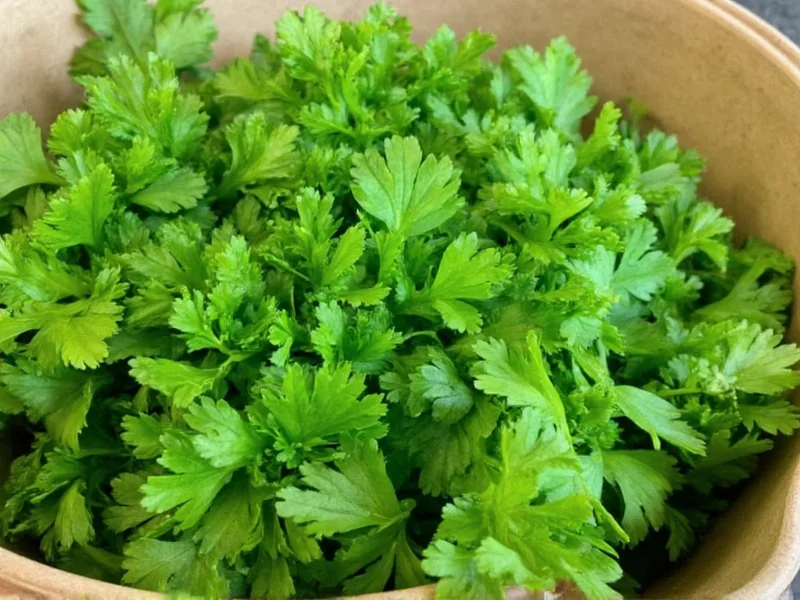Understanding the Visual Differences Between Parsley and Cilantro
When standing in the grocery store unsure which herb you're holding, visual identification is your first line of defense. Though both belong to the Apiaceae family and share a superficial resemblance, several key characteristics set them apart. Parsley (Petroselinum crispum) typically comes in two varieties: curly leaf and Italian (flat-leaf). Curly parsley has ruffled, tightly curled leaves that form a dense rosette, while Italian parsley features broader, flatter leaves with distinct serrated edges. Both varieties maintain a deep green color that doesn't yellow easily. Cilantro (Coriandrum sativum), also known as Chinese parsley or coriander leaf, has delicate, lacy leaves that appear more rounded and feathery. The outer leaves are broader while the inner leaves become increasingly fern-like. Cilantro tends to have a brighter, more vibrant green hue compared to parsley.| Characteristic | Parsley | Cilantro |
|---|---|---|
| Leaf Shape | Broad, flat with serrated edges (Italian) or tightly curled (curly) | Rounded, lacy, feathery appearance |
| Stem Structure | Straight, firm, and relatively thick | More delicate, angular, and hollow |
| Color | Deep, dark green | Bright, vibrant green |
| Aroma | Mild, grassy, slightly peppery | Strong citrus notes, sometimes soapy |
Flavor Profiles: Why Substituting Matters
The flavor difference between parsley and cilantro significantly impacts your cooking. Parsley offers a mild, fresh taste with subtle peppery notes that complements rather than dominates dishes. Chefs often use it as a garnish because it adds visual appeal without altering the fundamental flavor profile. Cilantro delivers a much more assertive flavor experience with pronounced citrus and herbal notes. Approximately 21% of the population carries a genetic variation that causes cilantro to taste like soap—a phenomenon known as cilantro soap taste. This genetic predisposition explains why some people passionately dislike cilantro while others enjoy its distinctive flavor. When substituting one for the other, consider the dish's cultural context. In Mediterranean cuisine, parsley appears in tabbouleh and gremolata, while cilantro features prominently in Mexican salsas and Indian chutneys. Swapping them can dramatically alter authentic recipes.Culinary Applications and Substitution Guidelines
Understanding when you can substitute parsley for cilantro (and vice versa) prevents culinary disasters. As a general rule:- Use parsley when you want subtle freshness without flavor dominance
- Choose cilantro when citrus notes will enhance the dish
- Never substitute in dishes where the herb is the star ingredient
- Consider cultural authenticity for traditional recipes
Growing and Storage Considerations
Home gardeners can distinguish parsley and cilantro plants through their growth habits. Parsley grows in a more upright, compact form with thicker stems, while cilantro tends to grow more loosely with thinner, more branching stems. Cilantro also bolts (goes to seed) much faster than parsley, especially in warm weather. For optimal freshness:- Store both herbs with stems in water, covered loosely with a plastic bag in the refrigerator
- Change water every two days to prevent wilting
- Wrap roots in damp paper towels for extended storage
- Cilantro typically lasts 5-7 days while parsley maintains quality for 7-10 days
Common Confusion Points and Practical Identification Tips
The most frequent confusion occurs between flat-leaf parsley and cilantro, as their leaf structures share some similarities. Here's how to confidently identify them:- Examine the leaf tips: Parsley leaves come to a definite point, while cilantro leaves have rounded edges
- Check the leaf texture: Parsley feels thicker and more substantial
- Smell the herb: Crush a leaf between your fingers—cilantro releases a strong citrus aroma
- Observe the stem color: Parsley stems are typically solid green while cilantro stems may show slight purple tinges
Addressing the Genetic Factor in Cilantro Perception
The reason some people find cilantro soapy while others enjoy it lies in genetics. Research shows that variations in olfactory receptor genes, particularly OR6A2, affect how we perceive aldehydes present in cilantro. These same compounds appear in soap, explaining the soapy taste association. If you're among those who dislike cilantro's flavor, consider these alternatives:- Use a combination of parsley and fresh mint for similar freshness without the soapy notes
- Try Vietnamese coriander (rau ram) which offers a similar flavor profile without the soapiness for some
- Add lime zest to mimic cilantro's citrus notes in recipes
Frequently Asked Questions
Can I substitute parsley for cilantro in guacamole?
Substituting parsley for cilantro in traditional guacamole significantly alters the flavor profile. Cilantro's citrus notes are integral to authentic guacamole. If you dislike cilantro, try using a small amount of fresh mint combined with parsley, or omit the herb entirely rather than using parsley as a direct substitute.
Why does cilantro taste like soap to some people?
Approximately 21% of people have a genetic variation in olfactory receptor genes, particularly OR6A2, that causes them to perceive certain aldehydes in cilantro as soapy. This genetic predisposition explains why some people strongly dislike cilantro while others enjoy its distinctive flavor.
How can I tell the difference between parsley and cilantro when they're dried?
Distinguishing dried parsley from dried cilantro is challenging since visual cues disappear. Dried cilantro typically has a stronger, more citrus-forward aroma compared to dried parsley's milder grassy scent. When in doubt, use small amounts and adjust to taste, as dried cilantro retains more flavor intensity than dried parsley.
Which herb is more nutritious, parsley or cilantro?
Both herbs offer nutritional benefits but with different profiles. Parsley contains significantly more vitamin K and vitamin C per serving, while cilantro provides more vitamin A. Both are low-calorie sources of antioxidants, but parsley generally offers higher concentrations of most vitamins and minerals when compared by volume.
Does cilantro turn into coriander?
Cilantro and coriander come from the same plant (Coriandrum sativum) but refer to different parts. Cilantro describes the fresh leaves and stems, while coriander refers to the dried seeds. The plant doesn't 'turn into' coriander—the seeds develop after the plant flowers, typically 3-4 weeks after maturity.











 浙公网安备
33010002000092号
浙公网安备
33010002000092号 浙B2-20120091-4
浙B2-20120091-4